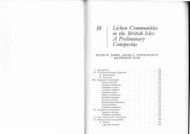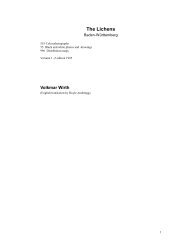Welsh Lichen Red List - Lichens of Wales
Welsh Lichen Red List - Lichens of Wales
Welsh Lichen Red List - Lichens of Wales
Create successful ePaper yourself
Turn your PDF publications into a flip-book with our unique Google optimized e-Paper software.
Rhestr o Gen Data Coch ar gyfer Cymru<br />
C Population size estimated to number fewer than the given number <strong>of</strong> individuals CR EN VU<br />
(an individual generally taken to be tree number for epiphytic species or discrete units<br />
<strong>of</strong> rock for epilithic taxa) and either:- 250 2500 10,000<br />
1) An estimated continuing decline <strong>of</strong> the given percentage in up to the last<br />
100 years or 25% 20% 10%<br />
2) An estimated decline observed or inferred in number <strong>of</strong> individuals<br />
(see above for definition <strong>of</strong> individual) and at least one <strong>of</strong> the following:-<br />
a) Population structure in form <strong>of</strong> one <strong>of</strong> the following:i)<br />
no sub population estimated to contain more than the given number <strong>of</strong><br />
mature individuals or 50 250 1000<br />
ii) at least the given % <strong>of</strong> mature individuals in one subpopulation. 90% 95% 100%<br />
b) Extreme fluctuations in number <strong>of</strong> mature individuals (see above for definition - - -<br />
<strong>of</strong> individual).<br />
D Population size estimated to number fewer than the given number <strong>of</strong> mature<br />
individuals (see above for definition) (D or D1). Or in the case <strong>of</strong> species considered<br />
for Vulnerable status, its population occupying a very restricted area (typically 5 or<br />
fewer locations) so rendering it vulnerable to extinction (D2). 50 250 1000<br />
E Probability <strong>of</strong> extinction is at least the given % within the next 100 years. 50% 20% 10%<br />
Table 1. Criteria used in <strong>Wales</strong> for evaluating species and deciding on their IUCN <strong>Red</strong> <strong>List</strong><br />
category<br />
NEAR THREATENED (NT)<br />
A taxon is Near Threatened when it is has been evaluated against the criteria but does not<br />
qualify for Critically Endangered, Endangered or Vulnerable now, but is close to qualifying<br />
for or is likely to qualify for a threatened category in the near future.<br />
LEAST CONCERN (LC)<br />
A taxon is Least Concern when it has been evaluated against the criteria and does not<br />
qualify for Critically Endangered, Endangered, Vulnerable or Near Threatened.<br />
Widespread and abundant taxa are included in this category.<br />
DATA DEFICIENT (DD)<br />
A taxon is Data Deficient when there is inadequate information to make a direct, or<br />
indirect, assessment <strong>of</strong> its risk <strong>of</strong> extinction based on its distribution and/or population<br />
status. Whilst Data Deficient could be considered not to be a category <strong>of</strong> threat, in<br />
practice it must be a matter <strong>of</strong> grave concern that a threat status cannot be assigned.<br />
Some <strong>of</strong> these species could be critically endangered. Consequently a high priority<br />
should be attached to securing resources to further investigate these species.<br />
NOT EVALUATED (NE)<br />
A taxon is Not Evaluated when it has not yet been evaluated against the criteria. There<br />
can be many reasons for this. Often it is due to some taxonomic issue.<br />
13





